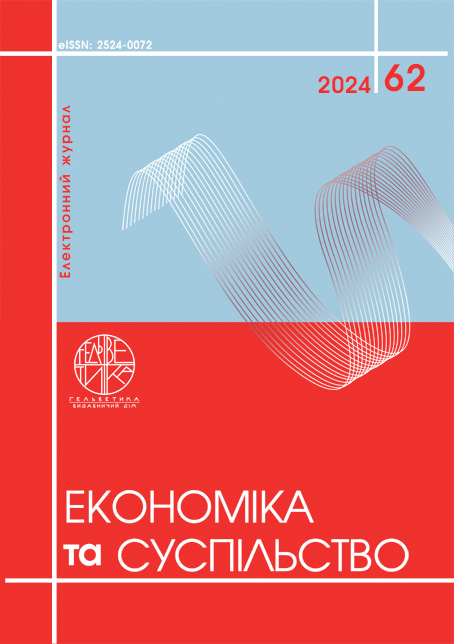USING BLOCKCHAIN TECHNOLOGY TO STABILIZE UKRAINE'S BANKING SYSTEM
Abstract
This article delves into the pressing challenges of Ukraine's banking system and explores innovative strategies for stabilization through the implementation of blockchain technology. The study underlines the major issues and obstacles that Ukraine's banking sector faces, particularly identifying the factors contributing to these challenges in the backdrop of a full-scale invasion. It further scrutinizes traditional methods used to address these issues, illustrating their practical application within Ukraine. The primary aim of this research is to consolidate a comprehensive list of the urgent problems facing Ukraine's banking system during wartime, evaluating classical stabilization methods, and suggesting additional improvement measures leveraging blockchain technology. The methodology involves a critical analysis of the existing banking issues and an investigation into how blockchain, with its key attributes, can be utilized to complement traditional stabilization methods that fall short in the current prolonged conflict scenario. Significant results from the research include the realization that classical methods, while beneficial in the short term, often lack the efficacy to sustainably manage ongoing crises, necessitating an innovative approach. Blockchain emerges as a potent alternative with its intrinsic characteristics of security, transparency, and efficiency. The application of smart contracts presents unique solutions previously unattainable with conventional methods. These self-executing contracts with pre-set terms coded into them eliminate the need for intermediaries, thus lowering operational costs and boosting transaction speed and reliability. This ensures automatic and tamper-proof execution of agreements, making them ideal for critical financial operations during periods of instability. Blockchain's role in risk management, through immutable transaction records and enhanced regulatory compliance, is also emphasized, showcasing its potential to revamp the banking sector's operational paradigms. In conclusion, the research underscores the dualities in adopting blockchain technology within the banking sector of a war-affected economy. While the benefits of increased security and operational efficiency are evident, the associated risks such as the requirement for highly specialized skills for smart contract coding and potential new forms of cyber-threats cannot be overlooked. Nonetheless, the shift towards blockchain represents a pivotal move towards not only stabilizing Ukraine's banking system but also propelling it into a more resilient and adaptable future. The study advocates further exploration into tailored blockchain solutions and strategic development to mitigate associated risks, ultimately enhancing the overall robustness of the banking ecology in Ukraine. This article holds substantial practical value by providing a thorough analysis of both traditional and innovative methods to stabilize a banking system amidst ongoing conflict, with a robust argument supporting the integration of blockchain technology as a viable and forward-thinking alternative.
References
Ситник Н., Пріцак Я. Банківська система України в умовах війни. Молодий вчений. 2023. №6(118). С. 94–98.
Черкашин І. Банківська система України в умовах війни: ключові виклики та важливі трансформації заради виживання. Формування механізму зміцнення конкурентних позицій національних економічних систем у глобальному, регіональному та локальному вимірах – 2023: матеріали X Міжнародної науково-практичної конференції (м. Тернопіль, 31 березня 2023 р.). Тернопіль. : ФОП Паляниця В. А, 2023. С. 87–90.
Еркес О., Калита О., Сундук, Т. Банківська система України в умовах війни. Scientia Fructuosa. 2022. №4(144). С. 122–133.
Рущишин Н., Пелех О., Козак А., Криворучко Н. Сучасний стан банківської системи України та перспективи її розвитку. Вісник ЛТЕУ. Економічні науки. 2024. №75. С. 27–36.
Szabo N. Formalizing and securing relationships on public networks. First Monday. 1997. vol 2(9). Available at:
https://firstmonday.org/ojs/index.php/fm/article/view/548/469 (accessed May 29, 2024)
Alharby M., Moorsel A. Blockchain-based Smart Contracts: A Systematic Mapping Study. ArXiv. 2017. DOI: 10.48550/arXiv.1710.06372. (accessed May 29, 2024)
Arner W., Auer R., Frost Jon, Stablecoins: Risks, Potential and Regulation. BIS Working Paper. 2020. vol 905. Available at: https://ssrn.com/abstract=3979495 (accessed May 29, 2024)
Nakamoto S. Bitcoin: A Peer-to-Peer Electronic Cash System, 2008. Available at: https://bitcoin.org/bitcoin.pdf. (accessed May 29, 2024)
Sytniк N., Pritsak Y. (2023) Bankivska systema Ukrainy v umovakh viiny [Banking System of Ukraine During the War]. Molodyi vchenyi – Young Scientist, no. 6(118), pp. 94–98.
Cherkashyn I. (2023) Bankivska systema Ukrainy v umovakh viiny: kliuchovi vyklyky ta vazhlyvi transformatsii zarady vyzhyvannia [Banking System of Ukraine During the War: Key Challenges and Important Transformations for Survival]. Formuvannia mekhanizmu zmitsnennia konkurentnykh pozytsii natsionalnykh ekonomichnykh system u hlobalnomu, rehionalnomu ta lokalnomu vymirakh – 2023: X Mizhnarodna naukovo-praktichna konferenciya (Ternopil, March 31, 2023). Ternopil: FOP Palyanytsia V. A, pp. 87-90. (in Ukrainian)
Erkes O., Kalyta O., Sunduk T. (2022) Bankivska systema Ukrainy v umovakh viiny [Banking System of Ukraine During the War]. Scientia Fructuosa, no. 4(144), pp. 122–133.
Rushchyshyn N., Pelekh O., Kozak A., Kryvoruchko N. (2024) Suchasnyi stan bankivskoi systemy Ukrainy ta perspektyvy yii rozvytku [Current State of the Banking System of Ukraine and Prospects for Its Development]. Visnyk Lvivskoho Torhovelno-Ekonomichnoho Universytetu – Bulletin of Lviv University of Trade and Economics. Ekonomichni nauky – Economic Sciences, no. 75, pp. 27–36.
Szabo N. (1997) Formalizing and securing relationships on public networks. First Monday, vol. 2(9). Available at: https://firstmonday.org/ojs/index.php/fm/article/view/548/469 (accessed May 29, 2024)
Alharby M., Moorsel A. (2017) Blockchain-based Smart Contracts: A Systematic Mapping Study. ArXiv. DOI: 10.48550/arXiv.1710.06372. Available at: https://arxiv.org/abs/1710.06372 (accessed May 29, 2024).
Arner W., Auer R., Frost Jon (2020) Stablecoins: Risks, Potential and Regulation. BIS Working Paper, vol. 905. Available at: https://ssrn.com/abstract=3979495 (accessed May 29, 2024)
Nakamoto S. (2008) Bitcoin: A Peer-to-Peer Electronic Cash System. Available at: https://bitcoin.org/bitcoin.pdf (accessed May 29, 2024)

This work is licensed under a Creative Commons Attribution 4.0 International License.


